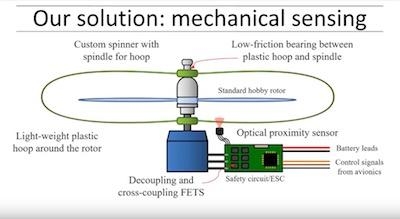Wed, Jun 06, 2018
Senses Proximity Of Biological Material To The Blades
Researchers at the University of Queensland in Australia are developing a sensor system that is designed to stop a spinning drone rotor blade before it can cause an injury.

The "Safety Rotor" is a cage around the rotor that spins more slowly than the propeller, and if a biological material is detected, stops the rotor within 0.077 seconds.
IEEE reports on its Spectrum website that the system consists of a plastic hoop that would touch any object, such as a finger, before it is contacted by the rotor blade. The hoops are spun passively by friction against the rotor hub and studded with IR reflectors that interface with an IR detector mounted near the rotor hub. If the IR signal is interrupted, it engages the rotor brake.
The system is expected to cost about $14 and weigh under 22 grams, so drone performance would not be impacted significantly.
According to the researchers:
"The measured latency [of the Safety Rotor’s braking response] was 0.0118 seconds from the triggering event to start of rotor deceleration. The rotor required a further 0.0474 s to come to a complete stop. Ninety percent of the rotational kinetic energy of the rotor (as computed from angular velocity) was dissipated within 0.0216 s of triggering, and 99 percent of the rotational kinetic energy of the rotor was dissipated within 0.032 s.
"The safety functionality of the safety system was tested on the bench using a processed meat “finger” proxy to trigger the hoop, and also applied to an open rotor (without hoop) for comparison. The rotor was spun at hover speed (1100 rads−1) and the finger proxy was introduced into the hoop at 0.36 ms−1 … The rotor and finger motion were captured using a shutter speed of 480 Hz. The rotor came to a stop within 0.077 s, with only light marks on the finger proxy from the impact of the hoop. The rotor was completely stopped by the time the finger reached the rotor plane. In contrast, the tip of the finger proxy introduced to an open rotor was completely destroyed."
(Image from University of Queensland YouTube video)
More News
From 2023 (YouTube Version): Legacy of a Titan Robert (Bob) Anderson Hoover was a fighter pilot, test pilot, flight instructor, and air show superstar. More so, Bob Hoover was an i>[...]
Get The Latest in Aviation News NOW on Instagram Are you on Instagram yet? It's been around for a few years, quietly picking up traction mostly thanks to everybody's new obsession >[...]
Aero Linx: B-52H Stratofortress The B-52H Stratofortress is a long-range, heavy bomber that can perform a variety of missions. The bomber is capable of flying at high subsonic spee>[...]
Altimeter Setting The barometric pressure reading used to adjust a pressure altimeter for variations in existing atmospheric pressure or to the standard altimeter setting (29.92).>[...]
"Knowing that we play an active part in bettering people's lives is extremely rewarding. My team and I are very thankful for the opportunity to be here and to help in any way we ca>[...]
 Classic Aero-TV: Remembering Bob Hoover
Classic Aero-TV: Remembering Bob Hoover ANN FAQ: Follow Us On Instagram!
ANN FAQ: Follow Us On Instagram! ANN's Daily Aero-Linx (05.15.24)
ANN's Daily Aero-Linx (05.15.24) ANN's Daily Aero-Term (05.15.24):Altimeter Setting
ANN's Daily Aero-Term (05.15.24):Altimeter Setting Aero-News: Quote of the Day (05.16.24)
Aero-News: Quote of the Day (05.16.24)



